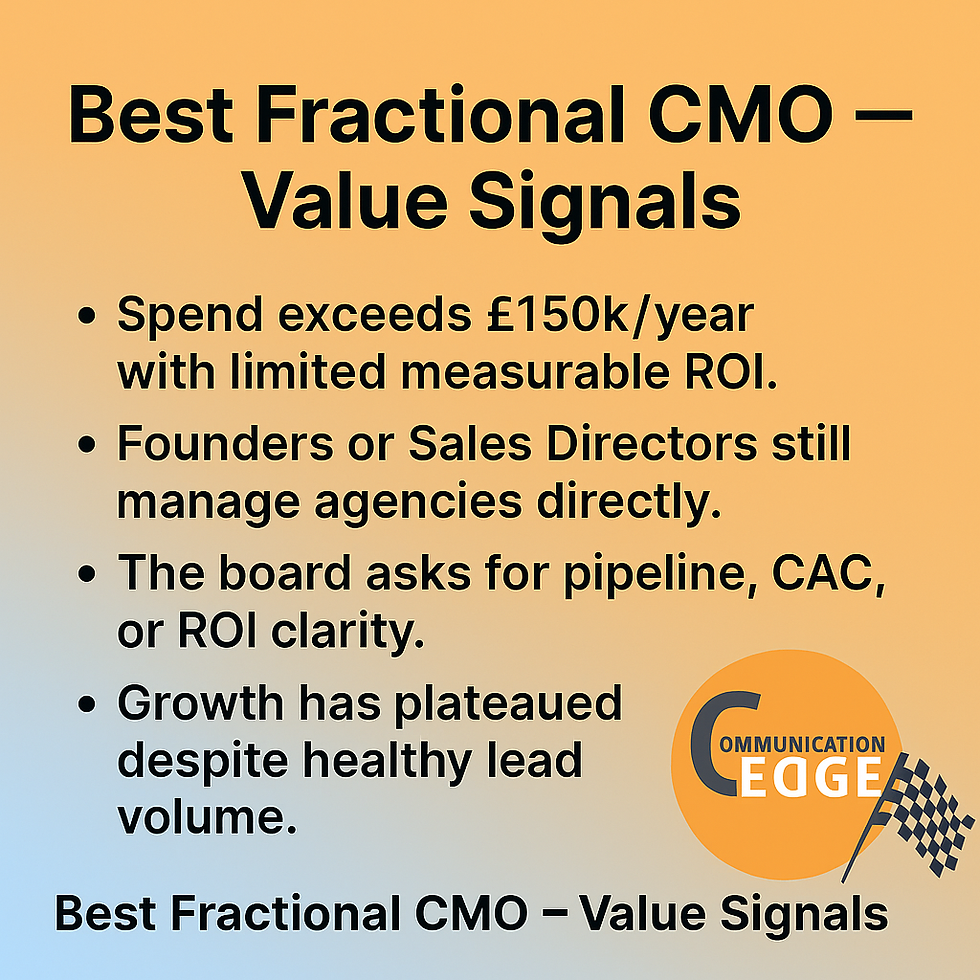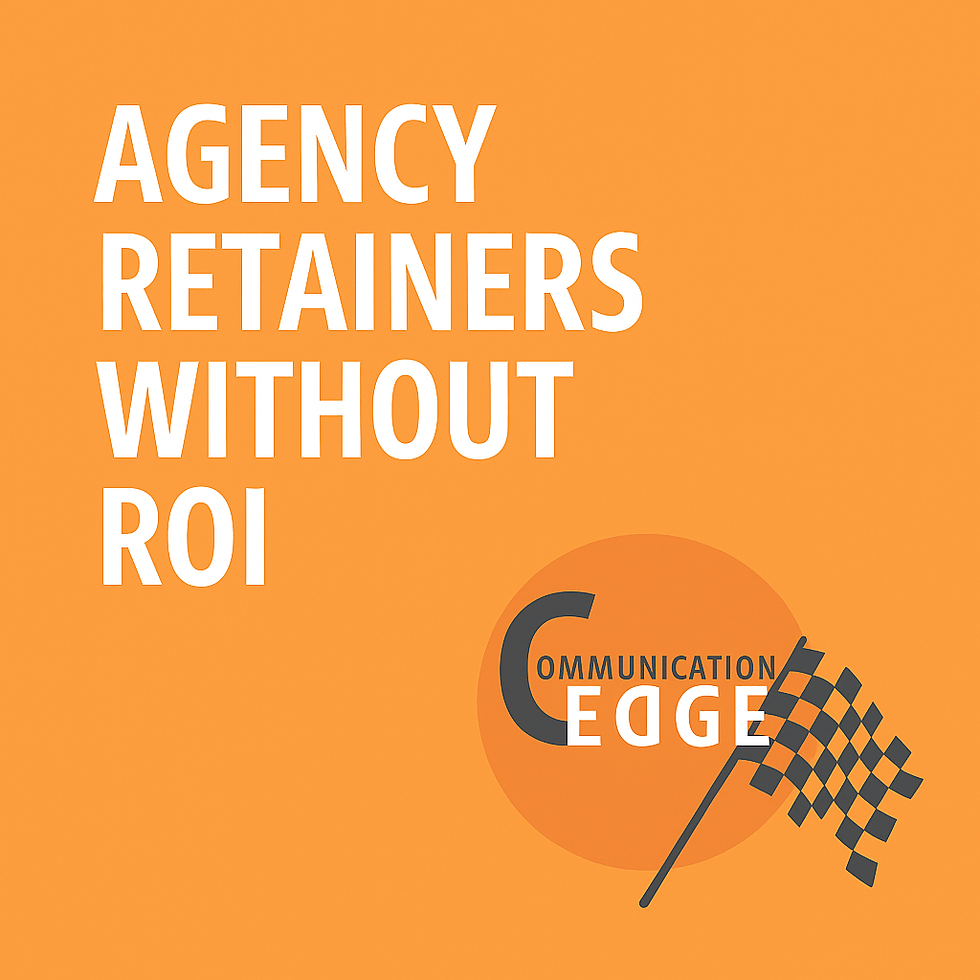FAQs on Switching from a Marketing Agency to a Fractional CMO Model
- Simon Hunt
- Sep 29
- 6 min read
Updated: Oct 18

For many SME owners and boards, moving away from a traditional agency to a Fractional CMO model can feel like a big leap.
To help you make an informed decision, here are the most common questions we hear from businesses considering the switch — and the answers that matter.
Fractional CMO FAQs -What happens if interns leave?
This is a fair concern. Unlike agencies, where staff turnover can mean losing your account manager overnight, the Fractional CMO model is built on resilience.
Interns are trained on AI-driven workflows, so knowledge is stored in systems, not just people.
Your Fractional CMO provides continuity, ensuring strategy and execution don’t skip a beat.
Standard operating procedures (SOPs) mean that if one intern leaves, another can step in quickly with minimal disruption.
Plus if you manage interns properly & fractional CMO's do there's usually plenty of notice and no shortage of bright fresh graduates to train up.
Result: No downtime, no disruption — your campaigns keep running at full speed.
Do I get the same creative quality as an agency?
Yes — and in many cases, higher quality with faster output.
Agencies rely on generalists juggling multiple clients. A Fractional CMO focuses only on your business goals.
Interns, backed by AI tools for content, SEO, design, and reporting, deliver output that meets or exceeds agency standards.
Quality is controlled by the CMO, who signs off on creative direction and ensures it aligns with your strategy.
The modern tools have so many checks on the detail relating to quality output and any shifts competitors make to their content, you can easily surpass an agency in quality and quantity of output.
Result: More assets, produced faster, with the same strategic polish you’d expect from a top-tier agency. We hope these Fractional CMO FAQs help.
Can this scale as we grow internationally?
Absolutely. The Fractional CMO model is designed to scale:
Start lean: CMO + 1–2 interns can deliver enterprise-level marketing for SMEs.
Scale up: Add more interns or part-time specialists (SEO, PPC, design) as campaigns grow.
Global-ready: AI-driven reporting means you can manage multiple markets, languages, and campaigns with clarity.
Result: Your marketing team grows only as fast as you need it — without heavy agency retainers.We hope these Fractional CMO FAQs help.
How do I start small?
Many SMEs begin with a 90-day pilot program:
Audit & Strategy – Your Fractional CMO reviews existing spend, performance, and growth gaps.
Quick Wins – Interns execute AI-powered campaigns that deliver early traffic and lead gains.
Board-Ready Reporting – Daily visibility on KPIs like CAC, pipeline, and rankings.
From there, you choose to scale. Unlike agencies, there are no long-term lock-ins or inflated retainers.
Result: Low-risk entry, measurable results within three months.We hope these Fractional CMO FAQs help.
How do I de-risk the change?
Firstly, we recommend a health check for a couple of sound reasons:
No 1 we get to see from the data where we are starting from, so we can see the initial issues that need addressing that will have an impact.
No 2 we get to prepare the research on your competition, so we can take steps to ascertain
How far behind you are?
How far ahead they are?
What potential traffic & leads you should be aiming for?
What your current share of traffic is?
Where the weaknesses are?
How hard the lifting will be to get results?
These results and answers are then communicated back to you in session 2 of the Marketing Health Check.
That creates a level of transparency and confidence to help you understand what gains your going to get, how quickly and what the cost of change is.
Other Common FAQ Questions
“Do I lose access to specialist expertise?” → No. Your CMO plugs in trusted freelancers or niche experts only when needed, keeping costs lean.
“How does AI really help interns?” → AI tools handle repetitive tasks (SEO research, content drafting, reporting), freeing interns to focus on execution at 15X the pace of manual methods.
AI Tools help with fast planning and de-risking the quality of output, they are so easy to use and educate the Interns as they use them. So you get high quality output and accelerated learning.
The Interns love that because they learn fast and contribute quickly, seeing their results almost instantly in the reporting toolset we use.
“Is this model right for every SME?” → It works best for SMEs who want data-driven marketing, measurable ROI, and boardroom accountability — without the agency fluff.
The biggest issue is that alot of people who are expert in their areas, think they can do marketing, and educating them gently that they no very little or put politely, enough to be dangerous is a tactful role the CMO takes on.
Additional FAQs to Cover Key Concerns
6. How does pricing compare to an agency retainer?
Answer:Fractional CMO teams typically deliver 30–40% cost savings by removing overheads and focusing on the channels that work.
7. Will I have less strategic input?
Answer:No. The CMO works closely with your leadership and reports directly to the board, ensuring marketing aligns with commercial goals.
8. How quickly will I see results?
Answer:Most SMEs see noticeable improvements in 60–90 days, particularly in inbound traffic, lead volume, and pipeline quality.
9. Do I lose access to specialist expertise?
Answer:No. Your CMO plugs in trusted freelancers or niche experts only when needed, keeping costs lean and avoiding bloated agency teams.
10. How do interns learn fast enough?
Answer:AI-powered workflows accelerate learning. Interns focus on execution and reporting while the CMO handles strategy and oversight.
11. Is it a risk to rely on AI tools?
Answer:Not at all. AI tools handle repetitive, error-prone tasks like research and reporting. The CMO still makes all strategic decisions.
12. How do you ensure brand consistency?
Answer:The CMO sets clear brand guidelines and approves all creative outputs. Centralised tools ensure consistent tone, style, and messaging.
13. What reporting will I get?
Answer:You’ll receive board-ready dashboards covering CAC, LTV, pipeline health, SEO rankings, and paid campaign ROI.
14. How flexible is the model if my needs change?
Answer:You can scale up or down as needed — unlike fixed agency retainers. The model adapts to your growth stage.
15. Can this replace my in-house team?
Answer:It can complement or replace your in-house team. Many SMEs keep one coordinator and add the Fractional CMO + Interns for expertise and output.
16. How is campaign performance reviewed?
Answer:Performance reviews are typically monthly with the board and weekly with your marketing lead, ensuring alignment and agility.
17. Will I lose my existing agency relationships?
Answer:Not necessarily. Some businesses keep agencies for niche tasks (e.g., video production) while moving strategy and execution to the CMO model.
18. Does the model work for product-based businesses as well as services?
Answer:Yes. It’s equally effective for B2B and B2C businesses — from SaaS and manufacturing to e-commerce and service-led SMEs.
19. How do you handle PPC and paid media?
Answer:The CMO sets strategy, interns handle execution, and niche experts are brought in for complex campaigns to optimise spend and ROI.
20. What if I want to bring marketing back in-house later?
Answer:The CMO builds your internal capability as you grow, training your future hires so you’re never locked in.
21. How secure is my data?
Answer:All data stays in your chosen CRM, dashboards, and reporting tools. Access is controlled and documented, ensuring compliance.
22. Will I get transparency on time spent and ROI?
Answer:Yes. Unlike agencies that hide work in retainers, you get clear time tracking and cost attribution per campaign.
23. How does this impact customer acquisition cost (CAC)?
Answer:By cutting waste and focusing spend on what works, most SMEs see CAC drop by 20–40% within the first six months.
24. Is there a minimum contract period?
Answer:No long-term lock-ins. Many start with a 90-day pilot, then move to rolling quarterly or six-month plans.
25. How does the model support crisis response or pivots?
Answer:The lean structure allows rapid campaign pivots within 48–72 hours, unlike agency processes that often delay response.
26. Can the interns handle technical SEO or analytics?
Answer:Interns use guided AI workflows for technical SEO and reporting, overseen by the CMO or niche consultants for complex fixes.
27. What happens if results don’t improve?
Answer:The CMO will reassess strategy, adjust campaigns, and show progress transparently. If expectations aren’t met, you’re not tied to a long contract.
28. How much time will the CMO spend on my business?
Answer:Typically 1–2 days per week, with interns covering daily execution. Time scales as your needs and campaigns grow.
29. How does this model work for multi-site or franchise businesses?
Answer:The AI-driven system and reporting make it easy to replicate successful campaigns across multiple sites or regions with local customisation.
30. How will this affect my leadership’s workload?
Answer:It will likely reduce it — the CMO leads strategy and interns handle execution, freeing leadership to focus on growth and board priorities.
Conclusion: Why SMEs Are Making the Switch
Traditional agencies struggle with cost, speed, and transparency. The Fractional CMO + Interns model delivers:
30–40% cost savings
10X faster planning
15X more output
Board-ready reports and full transparency
If you’re tired of agency retainers and ready for marketing that proves ROI, the Fractional CMO model may be your next competitive edge.
CTA: Book your free Marketing Health Check today to explore how a Fractional CMO team can transform your SME.





Comments